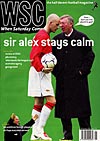 Apparent misfits in the Premiership, more than a few imports have gone on to have perplexingly good careers elsewhere. We tracked down three of them, Craig McCracken looking at Marc-Vivien Foé
Apparent misfits in the Premiership, more than a few imports have gone on to have perplexingly good careers elsewhere. We tracked down three of them, Craig McCracken looking at Marc-Vivien Foé
Marc-Vivien Foé was an early developer. A first team regular for Cameroon’s top club Canon Yaoundé at 17, an international at 18, a World Cup player at 19, he won his first transfer to Europe when he signed a contract shortly after his 20th birthday to join Lens.
Foé settled quickly. His selfless game and self-effacing personality dovetailed well with the nature of the Lensoises, the club reflecting strongly the no-nonsense, hardworking attitude prevalent in this mining town. Working under the astute tutelage of Daniel Leclerq, Foé’s strength and positional sense improved notably. By his third season at Lens, Foé had emerged as a midfield powerhouse with guile and presence to match his ferocious tackling. He proved a key component in the club’s shock title success in 1998, his exemplary performances as midfield anchor allowing Vladimir Smicer and Stéphane Ziani to concentrate on creative duties.
By now the European giants were circling. Alex Ferguson stated his interest early, as it became clear that he saw the player as an ideal midfield foil for Roy Keane at Old Trafford. Preliminary transfer discussions had started as the player travelled to a pre-World Cup training camp in Italy, when disaster struck. An innocuous challenge on Foé badly broke his left leg, he was out of France 98 and, despite encouraging noises from Old Trafford, his Manchester United prospects faded as it became clear he would be out for some time.
Cameroon missed his calming presence during the World Cup and so did Lens the following season. Their team was breaking up, and Foé was soon to move on, becoming West Ham’s record signing at £4.5 million. His time in England was mixed. He appeared to have a problem adjusting to the pace of the Premiership and his most notable contribution was to get himself booked in eight of the 13 games he played in 1998-99. Although the club’s final position of fifth was the second highest in its history, defeats of 4-0, 5-1 and 6-0 were enough to convince many fans of Foé’s worth as a ball-winning midfielder. Many also felt he was not as good in the air as he should have been at 6ft 4in.
But the next season saw a dramatic transformation. Perhaps it was the excitement of West Ham’s Intertoto campaign and subsequent foray into the UEFA Cup, but suddenly Foé was bossing midfield – and timing his tackles. He even managed to score a couple of goals in his 35 appearaces, while he was only booked seven times – although he did manage two red cards.
However, the writing was on the wall from March 2000, when loan signing from Lyon Frédéric Kanouté made one of the most promising debuts regulars at the Boleyn could remember. Harry Redknapp had no choice but to sign him up, but had to sell before first. The obvious thing to do was to sell Foé – and £6 million from Lyon, another record fee for West Ham, was too good to turn down.
Calamity befell the unlucky Foé again before his Lyon career could get off the ground. He contracted malaria in the summer of 2000, and it was not until the second half of last season that he was able to show his worth again, playing a strong role in the club’s push to second place in the table and in the Champions League. This season, Foé has been a fixture. His galvanising presence may push Lyon towards their first ever title, just as he did with Lens four seasons ago.
While Foé was not exactly a failure during his time at West Ham, Glenn Roeder couldn’t half do with a tough-tackling, hard-running powerhouse of an international midfielder now.
From WSC 179 January 2002. What was happening this month